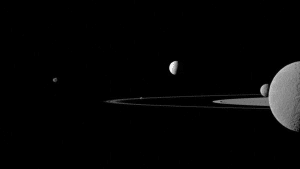TAG: GS 3: SCIENCE AND TECHNOLOGY
THE CONTEXT: Enceladus, Saturn’s captivating moon, has recently garnered attention due to its potential to harbor life.
EXPLANATION:
Enceladus:
- Despite being merely 313 miles (504 kilometers) in diameter, it boasts a significant feature: a liquid water ocean beneath its icy crust, stretching across the entirety of the moon’s surface.
- The revelation of Enceladus’s hidden ocean stems from the groundbreaking Cassini-Huygens mission, a collaborative endeavor involving NASA, the European Space Agency, and the Italian Space Agency.
- Conducted from 2004 to 2017, this mission meticulously probed Saturn, its majestic rings, and its diverse moons.
- Among its myriad discoveries were plumes of water emanating from a sub-surface salty ocean, interacting with rocky structures at the ocean’s base.
- Enceladus’s ocean mirrors Earth’s own aquatic expanses in some remarkable ways.
- Researchers, utilizing instruments like the dust analyzer, have discerned crucial components within the moon’s icy grains.
- Most notably, sodium chloride, or table salt, dominates the ocean’s saline composition.
- Moreover, a plethora of carbon-based compounds, vital for biochemical processes, have been identified.
- Additionally, the moon’s tidal heating mechanism generates internal energy, further enhancing its potential as a habitat for life forms.

Brightly reflective Enceladus appears above the center of the image
Recent Discoveries
- In a significant development in 2023, scientists, including Fabian Klenner from the University of Washington, unearthed phosphate—a compound conducive to life—in ice grains originating from Enceladus’s ocean.
- This discovery bolsters the moon’s candidacy as a viable environment for primitive life forms.
- Moreover, experts speculate that Enceladus’s environment may resemble the conditions that nurtured life on Earth, fueling excitement for further exploration.
Future Missions
- Enceladus’s allure has not escaped the attention of space agencies.
- In 2022, NASA earmarked a mission to Enceladus with the second-highest priority, underscoring the moon’s scientific significance.
- Likewise, the European Space Agency recently designated Enceladus as the primary target for its forthcoming mission, indicative of the global scientific community’s interest in unlocking the mysteries of this enigmatic moon.
Mimas: Unveiling Hidden Depths
- Joining the ranks of celestial bodies harboring potential sub-surface oceans is Mimas, another of Saturn’s moons.
- Beneath its icy exterior lies a vast concealed ocean, as unveiled by scientists in February of the current year.
- This ocean possesses many of the fundamental ingredients conducive to hosting rudimentary extraterrestrial life forms.
- Mimas’s revelation adds to a burgeoning family of icy moons within the Solar System suspected of concealing inner oceans.
- This expanding roster includes other notable moons such as Europa and Ganymede of Jupiter, as well as Enceladus itself.
- The existence of these subsurface oceans raises intriguing questions about the potential prevalence of habitable environments beyond Earth.
Titan: A World of Extremes
- Beyond Enceladus and Mimas, Saturn boasts Titan, a moon renowned for its distinctive characteristics.
- Titan stands out as the only moon in the Solar System with a substantial atmosphere, primarily composed of nitrogen with traces of methane.
- Its surface features include vast methane lakes and rivers, evoking comparisons to Earth’s hydrological cycle.
- Despite its frigid temperatures and hydrocarbon-rich environment, Titan intrigues scientists as a potential abode for life, albeit of a vastly different nature than terrestrial organisms.
- The presence of liquid methane and ethane raises tantalizing possibilities for exotic forms of biochemistry, challenging our understanding of the conditions necessary to sustain life.

